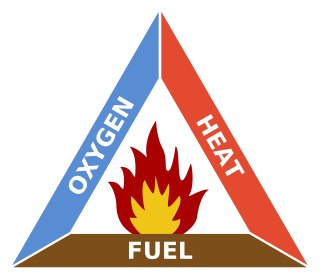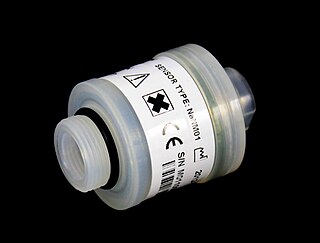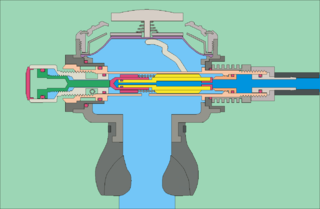Oxygen service
Oxygen service implies use in contact with high partial pressures of oxygen. Generally this is taken to mean a higher partial pressure than possible from compressed air, but also can occur at lower pressures when the concentration is high.
Oxygen cleaning
Oxygen cleaning is preparation for oxygen service by ensuring that the surfaces that may come into contact with high partial pressures of oxygen while in use are free of contaminants that increase the risk of ignition. [2]
Oxygen cleaning is a necessary, but not always a sufficient condition for high partial pressure or high concentration oxygen service. The materials used must also be oxygen compatible at all expected service conditions. Aluminium and titanium components are specifically not suitable for oxygen service. [2]
In the case of diving equipment, oxygen cleaning generally involves the stripping down of the equipment into individual components which are then thoroughly cleaned of hydrocarbon and other combustible contaminants using non-flammable, non-toxic cleaners. Once dry, the equipment is reassembled under clean conditions. Lubricants are replaced by specifically oxygen- compatible substitutes during reassembly. [2]
The standard and requirements for oxygen cleaning of diving apparatus varies depending on the application and applicable legislation and codes of practice. For scuba equipment, the industry standard is that breathing apparatus which will be exposed to concentrations in excess of 40% oxygen by volume should be oxygen cleaned before being put into such service. [2] Surface supplied equipment may be subject to more stringent requirements, as the diver may not be able to remove the equipment in an accident. Oxygen cleaning may be required for concentrations as low as 23% [3] Other common specifications for oxygen cleaning include ASTM G93 and CGA G-4.1. [4]
Cleaning agents used range from heavy-duty industrial solvents and detergents such as liquid freon, trichlorethylene and anhydrous trisodium phosphate, followed by rinsing in deionised water. These materials are now generally deprecated as being environmentally unsound and an unnecessary health hazard. Some strong all-purpose household detergents have been found to do the job adequately. They are diluted with water before use, and used hot for maximum efficacy. Ultrasonic agitation, shaking, pressure spraying and tumbling using glass or stainless steel beads or mild ceramic abrasives are effectively used to speed up the process where appropriate. Thorough rinsing and drying is necessary to ensure that the equipment is not contaminated by the cleaning agent. Rinsing should continue until the rinse water is clear and does not form a persistent foam when shaken. Drying using heated gas – usually hot air – is common and speeds up the process. Use of a low oxygen fraction drying gas can reduce flash-rusting of the interior of steel cylinders. [2]
After cleaning and drying, and before reassembly, the cleaned surfaces are inspected and where appropriate, tested for the presence of contaminants. Inspection under ultraviolet illumination can show the presence of fluorescent contaminants, but is not guaranteed to show all contaminants. [2]
Oxygen service design
Design for oxygen service includes several aspects:
- Choice of oxygen compatible materials for exposed components. [5]
- Minimising exposed area of materials which are necessary for functional reasons but are less compatible, and avoiding high flow velocities in contact with these materials. [5]
- Providing effective heat transfer to avoid raised temperatures of components. [5]
- Minimising the possibility of adiabatic heating by sudden increases of pressure - for example by using valves which cannot be opened suddenly to full bore, or opening against a pressure regulator. [5]
- Providing smooth surfaces in contact with flow where practicable, and minimising sudden changes in flow direction.
- Use of flame arrestors/Flashback arrestors/Oxygen firebreaks in flexible hose
| | This section needs expansion. You can help by adding to it. (June 2018) |
Oxygen compatible materials
As a general rule, oxygen compatibility is associated with a high ignition temperature, and a low rate of reaction once ignited. [6]
Organic materials generally have lower ignition temperatures than metals considered suitable for oxygen service. Therefore the use of organic materials in contact with oxygen should be avoided or minimised, particularly when the material is directly exposed to gas flow. When an organic material must be used for parts such as diaphragms, seals, packing or valve seats, the material with the highest ignition temperature for the required mechanical properties is usually chosen. Fluoroelastomers are preferred where large areas are in direct contact with oxygen flow. Other materials may be acceptable for static seals where the flow does not come into direct contact with the component. [6]
Only tested and certified oxygen compatible lubricants and sealants should be used, and in as small quantities as is reasonably practicable for effective function. Projection of excess sealant or contamination by lubricant into flow regions should be avoided. [5]
Commonly used engineering metals with a high resistance to ignition in oxygen include copper, copper alloys, and nickel-copper alloys, and these metals also do not normally propagate combustion, making them generally suitable for oxygen service. They are also available in free-cutting, castable or highly ductile alloys, and are reasonably strong, so are useful for a wide range of components for oxygen service. [6]
Aluminium alloys have a relatively low ignition temperature, and release a large amount of heat during combustion and are not considered suitable for oxygen service where they will be directly exposed to flow, but are acceptable for storage cylinders where the flow rate and temperatures are low. [5]











